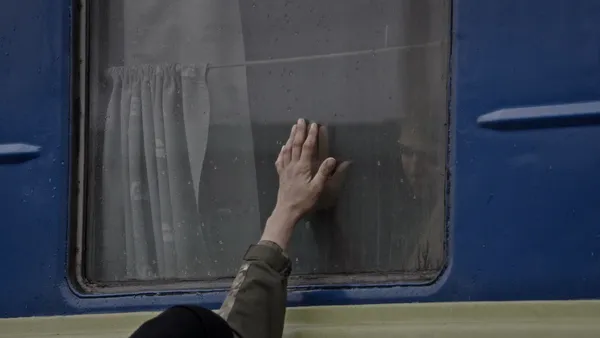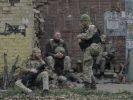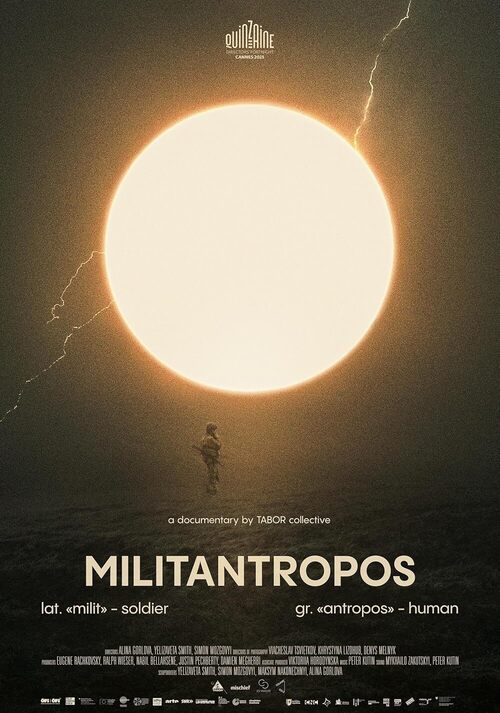Eye For Film >> Movies >> Militantropos (2025) Film Review
Militantropos
Reviewed by: Sergiu Inizian

The arrivals board in the Kyiv train station stands empty before a group of people. Against a dim light, the blank schedule lines cascade to the bottom of the panel, forming a black monolith that covers their silhouettes in darkness. As the intercom announces an evacuation train bound for Vienna, the image cuts to a large group of refugees approaching the station. Standing still, the camera absorbs their collective trauma against a background defined by silence and the faintest presence of snow. This scene stands at the core of the aesthetics employed by documentarians Yelizaveta Smith, Alina Gorlova and Simon Mozgovyi to explore the psyche of a country under assault. Adopting a style that blends collage and observational filmmaking, they probe how human minds and bodies contort, struggle and resist against a cruel war and its repercussions.
A protagonist becomes redundant when an incisive camera captures a mosaic of fight or flight situations that portray a Ukrainian society under threat from a war that feels like a supernatural catastrophe. Under swelling ashen clouds, a montage of burnt fields, ruined bridges, and incinerated tanks intertwine to form the terrifying home of the Militantropos (translated as human-soldier or human as soldier); a war-torn entity that emerges throughout the documentary.

Its first avatar, the average Ukrainian conscript, is consumed most days by routine. The static lens makes loading up howitzers and mortars seem monotonous and even surgical, despite the disquieting sound. Brazen shockwaves from the batteries bring the viewer closer to the reality of war and create an environment in which the soldiers’ fragility reemerges. Discarding the interview device entirely, the filmmakers boldly insert themselves into the lives of the enlisted men and women. We see them complain about their small quarters, watching a football match and recording themselves reciting love poems. The camera acts as a surrogate for the viewer, patiently guiding us through their predicament and refusing any unnecessary close-ups. Cutting away from the frontline, we see a group of civilians preparing to be recruited into the resistance force. As they train in formation and get accommodated with their weapons, the camera dares to push in, revealing a nervous blinking tick, shared among most men.
A second expression of the Militantropos is found among the ruins – everyday people who remain rooted, despite the atrocity that threatens to push them away with each passing day. We see a young couple tending to their fields even as they voice their concern about an impending drought. As their day fades under the sepia-coloured sunset, their future remains undetermined. The presence of farm animals is prominent in such segments, cats, dogs and even a stubborn goat offering a sense of vigorous life among the sight of crushed homes and barren farms. Life and hardiness travel through song as well, the rigorous camera capturing two elderly women getting teary-eyed while remembering a folk song against a backdrop adorned with traditional fabrics and motifs. Around these characters, the filmmakers develop a sense of perseverance, even against the surrounding desolation.
Song also finds its way into the lives of Ukrainian children, seen in Militantropos as lively and hopeful. As they run through urban trenches, their singing resonates throughout the neighbourhood, even as the camera focuses on discarded tanks. Elsewhere, a small child redirects refugees with a large Ukrainian flag, an act for which he's later rewarded with an armband. Despite a somewhat cold observational style, the filmmakers take their time to absorb the hope around the youth of the war-torn country. Naturally, hardship manifests in children as well, their innocent and tearful eyes further accentuating the war’s cruelty. As the camera closes in on a toddler's face while listening to Christmas carols in a train station ceremony, the harmony of the performers slowly fades out. In its place, Peter Kutin's soundscape, crafted out of war sirens, shelling and a haunting murmur, signals the end of respite and an impending darkness, occasionally pierced by the crack of convulsive gunfire.
Smith, Gorlova and Mozgovyi's vision acts as a sprawling incursion into the psyche of Ukrainians struggling against Russia's inhumane ambition, oftentimes spotlighting life on the battlefield. As the fixed camera work ventures far beyond routine military operations, it faces a nightmarish landscape, expressed through the interplay of blood-red and monochrome infrared cameras. Suddenly transported to a makeshift hospital, the cinematic eye focuses on the soldiers' faces, revealing the final rendition of the Militantropos, tormented by the numbing reality of an unjust invasion.
Reviewed on: 22 May 2025

















